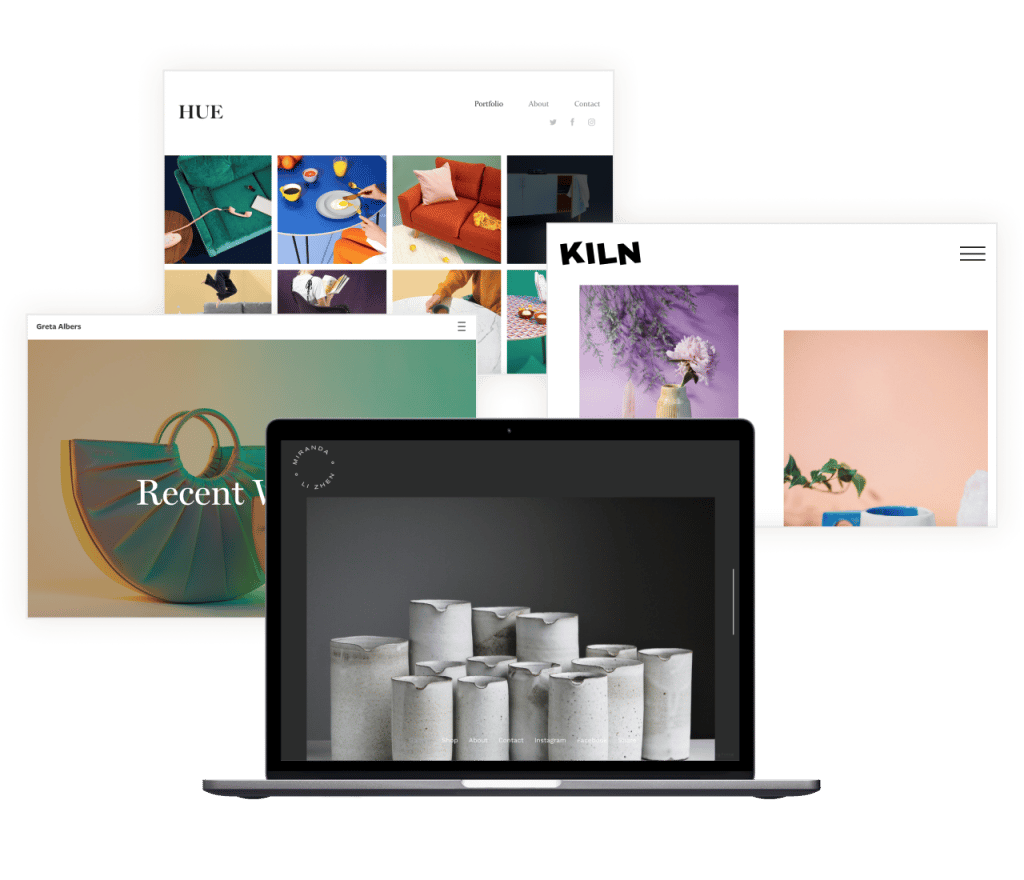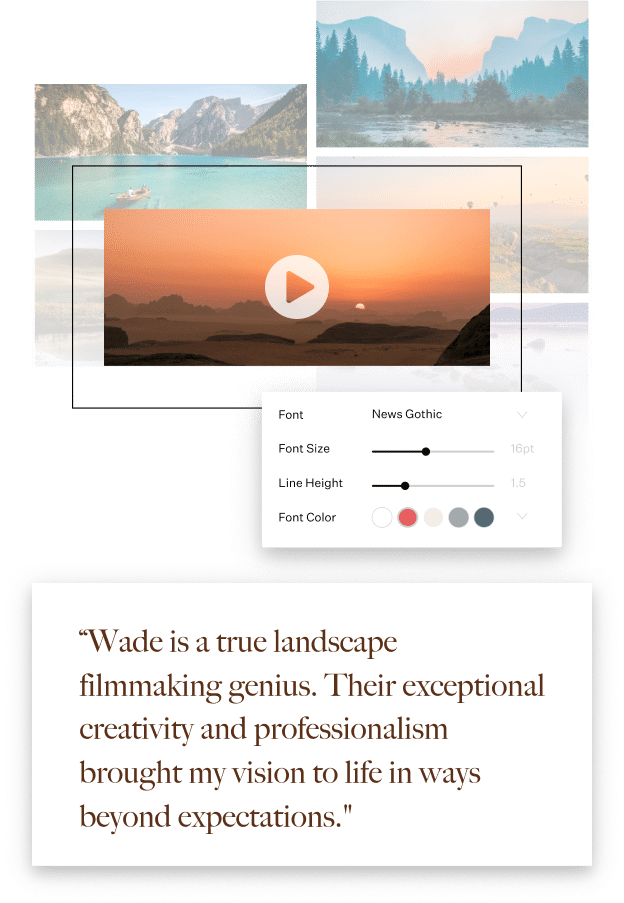Hattest du Probleme damit Erstelle deine Portfolio-Homepage um deine Fähigkeiten, dein Talent und deine Expertise zu präsentieren? Manchmal verschwimmen die traditionellen Grenzen der Kreativbranche, was den Aufbau eines gut gestalteten Portfolios noch wichtiger macht. Eine Portfoliohomepage ist eine gute Möglichkeit, um deine Dienstleistungen zu bewerben, aber sie erfüllt noch viel mehr Zwecke als das.
Eine Portfolio-Homepage ist ein virtuelles Tor, das potenziellen Kunden, Mitarbeitern und Arbeitgebern einen kurzen Einblick in den kreativen Ausdruck, die Erfahrung und die Fähigkeiten einer Person bietet. Sie bietet einer Person eine einzigartige Möglichkeit, ihren kreativen Prozess zu erklären und gleichzeitig zum Ausdruck zu bringen, was ihre Marke bietet. Eine Portfolio-Homepage bietet Kreativen die Möglichkeit, ihre Arbeit bestmöglich zu präsentieren.
Die Homepage eines Kreativportfolios kann als digitale Visitenkarte für Personen betrachtet werden, die ihre kreativen Dienstleistungen bewerben. Eine gut gestaltete Portfolio-Homepage sollte ein nahtloses Nutzererlebnis bieten, das die Website-Besucher/innen durch eine Geschichte führt, die hinter den kreativen Leistungen steht. Sie sollte Emotionen wecken, das Publikum ansprechen und einen bleibenden Eindruck hinterlassen, der die Besucher zum Handeln veranlasst.
In diesem Artikel geben wir dir eine Schritt-für-Schritt-Anleitung zur Erstellung deiner eigenen Portfolio-Homepage. Wir zeigen dir, wie wichtig es ist, die richtige Plattform für deine Bedürfnisse auszuwählen, erklären dir, wie wichtig Design und Layout-Funktionalität sind, wie du deine besten Arbeiten präsentierst, wie du eine Geschichte hinter deiner Marke erstellst und vieles mehr!
1. Wähle den richtigen Website-Builder
Wenn du deine kreative Portfolio-Homepage starten willst, ist die Wahl des richtigen Website-Builders wichtig für den Ausbau deiner Online-Präsenz. Auf dem Markt gibt es viele Optionen, aber es ist hilfreich, jede einzelne sorgfältig zu prüfen, um sicherzustellen, dass sie deinen Bedürfnissen entspricht.
Verschiedene Plattformen evaluieren
Bevor du mit einer kreativen Portfolio-Homepage anfängst, solltest du dir unbedingt die Zeit nehmen und dich über verschiedene Website-Baukästen informieren. Bei der Vielzahl der verfügbaren Website-Baukästen kann es einschüchternd sein, den richtigen für dich zu finden. Jeder hat seine eigenen Vor- und Nachteile, Integrationsmöglichkeiten und Kosten.
Anpassungsmöglichkeiten berücksichtigen
Ein weiterer wichtiger Faktor, den du bei der Erstellung deiner Homepage für dein Kreativportfolio berücksichtigen solltest, ist die Anpassbarkeit. Kreativschaffende neigen dazu, Optionen zu wählen, die sie an ihren Stil anpassen können. Ein Homepage-Builder sollte mit anpassbaren Layouts, Typografie, Farbschemata und Möglichkeiten zur Anpassung der Ästhetik ausgestattet sein. Die Präsentation deiner kreativen Arbeit sollte auf eine optisch ansprechende Weise erfolgen, die bei potenziellen Kunden und Website-Besuchern einen bleibenden Eindruck hinterlässt.
Kompatibilität
Ein weiterer Faktor, der bei der Erstellung einer Portfolio-Homepage oft übersehen wird, ist die Suche nach einer Plattform, die sich mit vielen der Tools integrieren lässt, die du bereits nutzt oder in Zukunft nutzen willst. Das Letzte, was du willst, ist, eine Portfolio-Homepage zu erstellen und später festzustellen, dass sie nicht mit deinen Dateiformaten oder Drittanbieter-Integrationen funktioniert.
Passt zu deinem Budget
Schließlich sollte die von dir gewählte Plattform oder der Website-Builder eng mit deinem Budget zusammenpassen. Schau dir die Preismodelle an, die von verschiedenen Plattformen angeboten werden. Du solltest dir auch die Gebühren für die Domainregistrierung, das Hosting und das SSL-Zertifikat ansehen. Bei einigen Plattformen und Domain-Hostern sind diese Dinge bereits inbegriffen, was ein Pluspunkt ist.
Wenn du diese Faktoren bei der Suche nach einem Website-Builder berücksichtigst, kommst du der Entscheidung für den richtigen Anbieter einen Schritt näher. Bei Format bieten wir eine einfach zu bedienende Lösung zur Erstellung von Portfolios an, die Folgendes bietet:
- Anpassbare Vorlagen mit dem du in wenigen Minuten eine beeindruckende Portfolio-Website erstellen kannst.
- Unbegrenzter Speicherplatz für deine Bilder und Videos.
- Tools zur Kundenprüfung, mit denen du deine Arbeit mit Kunden teilen und Feedback erhalten kannst.
- E-Commerce-Integration, die es dir ermöglicht, deine Arbeiten direkt von deiner Website aus zu verkaufen.
- SEO-Optimierung, damit deine Website in den Suchmaschinenergebnisseiten (SERPs) besser platziert wird.
- Mobiles Design, das sicherstellt, dass deine Website auf jedem Gerät gut aussieht.

2. Überlegungen zu Design und Layout
Die Aufmerksamkeit deiner Besucherinnen und Besucher zu gewinnen, spielt eine wichtige Rolle dabei, ob sie sich entscheiden, mit dir Kontakt aufzunehmen oder deine Website zu verlassen. Es gibt eine Reihe von Möglichkeiten, deine Arbeit so zu präsentieren, dass du dein Publikum optimal ansprechen kannst.
Wähle ein visuell ansprechendes und intuitives Design
Das Design, das du wählst, sollte deinen kreativen Stil und die Art deiner Arbeit ergänzen. Wenn du zum Beispiel Hochzeitsfotograf bist, möchtest du vielleicht die besten Arbeiten aus deinem Portfolio hervorheben, ohne den Betrachter mit bunten Farben auf der Seite zu überwältigen. In diesem Fall solltest du dich für ein sauberes, übersichtliches Design entscheiden, bei dem deine Arbeit mehr im Mittelpunkt steht als die Farben deiner Website.
Organisiere deinen Inhalt
Alle Inhalte auf deiner Portfolio-Homepage sollten logisch und kohärent aufgebaut sein. Angenommen, du bist ein Fotograf, der viele verschiedene Arten von Fotodienstleistungen aus unterschiedlichen Genres anbietet. In diesem Fall solltest du Abschnitte, Unterabschnitte und Kategorien einrichten, die sich auf die verschiedenen Arten der Fotografie beziehen, die du anbietest. Das bedeutet, dass du die Hochzeits- und die Food-Fotografie nicht in denselben Abschnitten unterbringen solltest. Versuche außerdem, klare und prägnante Überschriften zu verwenden, die deinen Besuchern helfen, deine Arbeit zu verstehen.
Struktur der Navigation
Die Navigationsstruktur hängt von der effektiven Gliederung deines Inhalts ab. Deine Portfolio-Homepage sollte einfach zu navigieren sein und es dem Besucher ermöglichen, zu verstehen, was du anbietest. Du solltest deine Menüpunkte übersichtlich halten, ohne deine Besucher/innen mit so vielen Optionen zu überfordern, dass sie verwirrt sind und am Ende nichts auswählen. Manchmal hilft es, eine Filterfunktion auf deiner Website einzubauen, die es den Nutzern ermöglicht, deine Inhalte leichter zu entdecken.
Optimiere für mobile Geräte
Heutzutage surfen etwa 80% der Nutzer/innen über ihr Handy im Internet. Wenn deine Portfolio-Homepage nicht für die mobile Nutzung optimiert ist, könntest du viele potenzielle Kunden verpassen, die an deinen Dienstleistungen interessiert sind. Stelle sicher, dass sich deine Homepage an verschiedene Bildschirmgrößen und Auflösungen anpasst. Bevor du deine Seite fertigstellst, solltest du sie auf verschiedenen mobilen Geräten testen, um sicherzustellen, dass alles richtig angezeigt wird. Auf vielen Plattformen kannst du sehen, wie eine Seite auf verschiedenen mobilen Geräten aussieht.
Jetzt, wo du mehr über Design und Layout-Konfigurationen weißt, lass uns dazu übergehen, wie du deine Arbeit präsentieren solltest, um ein breiteres Publikum zu erreichen.
3. Präsentiere deine beste Arbeit
Du solltest immer deine beste Arbeit präsentieren, um einen bleibenden Eindruck bei deinen Besuchern zu hinterlassen.
Stelle eine Auswahl deiner Top-Projekte zusammen
Anstatt dein Publikum mit einer riesigen Auswahl deiner Arbeiten zu bombardieren, solltest du dich darauf konzentrieren, nur die zu verwenden, die deiner Meinung nach deine Arbeit am besten repräsentieren. Qualität statt Quantität ist hier das Wichtigste. Wenn du für die Fotografie von Lebensmitteln wirbst, solltest du die besten Bilder in dein Portfolio aufnehmen.
Hebe Vielfalt und Tiefe in deinem Portfolio hervoro
Wenn du ein Fotograf bist, der viele verschiedene Fotostile beherrscht, solltest du versuchen, die besten Beispiele für jeden Stil auf deiner Portfolio-Homepage zu zeigen. Wie bereits erwähnt, solltest du deine Arbeiten auch entsprechend kategorisieren. Versuche, Fotos von Lebensmitteln, Hochzeiten und Landschaften in eigenen Rubriken unterzubringen.
Beschreibung und Kontext für jedes Projekt einbeziehen
Damit die Kunden deine Arbeit besser verstehen, kannst du auf deiner Kreativportfolio-HomepageEs ist hilfreich, Beschreibungen einzufügen, um die Dinge in einen Kontext zu stellen. Versuche, die Ziele oder Ergebnisse jedes Fotos oder jeder Fotogruppe, die du verwendest, kurz zu beschreiben. Um eine tiefere Verbindung zu den Website-Besuchern herzustellen, ist es außerdem hilfreich, einzigartige Aspekte zu erwähnen, die jedes Projekt unvergesslich machen.
Multimedia-Elemente effektiv nutzen
Wenn du multimediale Elemente in deine kreative Portfoliohomepage einbindest, wird die Aufmerksamkeit deiner Videos auf dich gerichtet sein. Versuche, hochwertige Bilder, Videos und andere interaktive Elemente einzubauen, die deine besten Arbeiten hervorheben. Der Einsatz von Multimedia-Elementen ist eine gute Möglichkeit, eine Geschichte rund um deine Arbeit zu erzählen.
4. Überzeugende Texte verfassen
Genauso wichtig wie die Präsentation einiger deiner besten Arbeiten auf deiner Homepage ist es, überzeugende Texte zu verfassen, die das Wesen deiner Arbeit vermitteln. Dein Text sollte dein Talent und dein Fachwissen klar vermitteln.
Schreibe eine fesselnde Überschrift
Um die Aufmerksamkeit deines Publikums gleich zu Beginn deiner Homepage zu erregen, solltest du eine fesselnde Überschrift schreiben, die dein Alleinstellungsmerkmal und deinen Stil effizient vermittelt. Versuche, eine Sprache zu verwenden, die die Neugier deiner Besucher/innen weckt und sie dazu verleitet, weiter durch deine Website zu scrollen. Schlüsselwörter oder Phrasen, die deine Nische widerspiegeln, sorgen dafür, dass deine Inhalte deine Zielgruppe erreichen.
Erstelle eine fesselnde Einleitung
Deine Einleitung ist deine Chance, als kreativer Profi zu glänzen. Halte sie so kurz wie möglich, während du hervorhebst, was du deinen Kunden bietest und was dich von deinen Mitbewerbern unterscheidet. Deine Einleitung soll dein Zielpublikum dazu inspirieren, bei deinem Portfolio zu bleiben und durch den Rest deiner Seite zu scrollen.
Beschreibe deinen kreativen Prozess und Ansatz
Eine gute Möglichkeit, mit Kunden in Kontakt zu treten, ist es, deinen kreativen Prozess zu beschreiben und zu zeigen, wie du Ideen zum Leben erweckst. Versuche, einige der Inspirationen, die hinter deiner Arbeit stehen, mitzuteilen und zu erklären, warum du einige Entscheidungen in Bezug auf deine Fotos getroffen hast. So zeigst du, dass du als kreativer Profi in der Lage bist, Probleme zu lösen, und ermöglichst es den Besuchern deiner Website, die Dinge aus deiner Perspektive zu sehen.
Hervorhebung der wichtigsten Errungenschaften und Meilensteine
Es ist auch hilfreich, einige deiner wichtigsten Erfolge als Kreativprofi auf deiner Portfolio-Homepage hervorzuheben. Wenn du in der Vergangenheit Auszeichnungen oder Anerkennungen erhalten hast, solltest du das in einer überzeugenden Sprache zum Ausdruck bringen.

5. Zeugnisse und Kundenfeedback einbeziehen
Binde Zeugnisse und Kundenfeedback in deine Homepage ein, um Glaubwürdigkeit zu schaffen und den sozialen Beweis zu erhöhen. Werfen wir einen Blick auf ein paar wichtige Überlegungen zur Verwendung von Zeugnissen und Kundenfeedback.
Bitte um Zeugnisse von zufriedenen Kunden oder Mitarbeitern
Versuche, Kunden aus der Vergangenheit zu kontaktieren, die mit deiner Arbeit sehr zufrieden waren, und bitte sie um ihr Feedback, das du auf deiner kreativen Portfolio-Homepage präsentieren kannst. Es ist hilfreich, wenn du dabei so konkret wie möglich bleibst. Gib an, wie sich deine Arbeit auf ihr Leben ausgewirkt hat und was sie am meisten geschätzt haben. Außerdem solltest du das Feedback auf deiner Website so einfach wie möglich gestalten.
Positive Bewertungen präsentieren
Versuche, die positivsten Bewertungen zuerst auf deiner Website zu präsentieren. Konzentriere dich auf Zeugnisse, die deine Professionalität, dein Talent und deine Kreativität hervorheben.
Setze Zeugnisse strategisch ein, um deine Glaubwürdigkeit zu stärken
Du solltest nicht nur einen eigenen Bereich für Zeugnisse einrichten, sondern sie auch in anderen Bereichen deiner Website platzieren, z. B. auf der Startseite oder direkt neben den Portfolio-Projekten.
6. Personalisiere deine Homepage
Um eine echte Verbindung zu deiner Zielgruppe herzustellen, solltest du deine Homepage für dein Kreativportfolio personalisieren, um dich von deinen Mitbewerbern abzuheben. Wenn du deine Homepage personalisierst, solltest du einige Dinge beachten.
Präsentiere deine Persönlichkeit
Lass deine Persönlichkeit auf der Homepage deines Kreativportfolios durchscheinen. Das mag auf den ersten Blick schwierig erscheinen, aber mit Hilfe von anpassbarer Designästhetik, Farbpaletten und Typografie kannst du einen Stil finden, der einen bleibenden Eindruck von deiner Authentizität hinterlässt.
Erwäge, persönliche Anekdoten zu erzählen
Eine weitere Möglichkeit, deine Homepage zu personalisieren, ist es, persönliche Anekdoten über deinen Weg zum Kreativberuf zu erzählen. Dadurch wird deine Seite menschlicher und Besucher/innen und potenzielle Kund/innen bekommen eine bessere Vorstellung davon, wie du zu dem geworden bist, was du heute bist.
Teile einige Interessen und Hobbys
Erwäge, ein paar Details über deine persönlichen Hobbys oder Interessen zu erzählen. Viele Reisefotografen sind Reisefotografen geworden, weil es ihr Hobby war. Menschen, die das, was sie tun, lieben, sind in der Regel auch sehr gut darin. Wenn du den Besuchern einen Einblick in deine Interessen gewährst, sind sie vielleicht auch eher bereit, dich für ihre Projekte auszuwählen.
Authentische Sprache verwenden
Versuche, die Verwendung branchenspezifischer Begriffe zu vermeiden, die dein Zielpublikum nur noch mehr verwirren können. Verwende eine einfache, aber verständliche Sprache (den Text auf deiner Website), die zu deiner Stimme passt.
7. Effektive Calls-To-Action (CTAs) implementieren
Eine gute Homepage für Kreativportfolios sollte CTAs haben, mit denen Besucher/innen etwas unternehmen können. Einige Beispiele für CTAs sind Kontaktbuttons, auf die Besucher/innen klicken können, um dich einfach zu erreichen, Newsletter-Abonnements oder Links, die zu mehr Informationen über dein Portfolio führen. Es gibt ein paar Strategien, die du bei diesem Schritt beachten solltest.
Wenn du deine CTAs gestaltest, solltest du dir überlegen, welche Aktionen deine Besucher/innen ausführen sollen. Dazu musst du dir ein paar Fragen stellen:
- Willst du, dass sie dich für eine Zusammenarbeit kontaktieren?
- Willst du, dass sie dein gesamtes Portfolio sehen?
- Willst du, dass mehr Besucher deinen Newsletter abonnieren?
Platziere CTAs strategisch auf deiner Homepage
Um die größte Wirkung zu erzielen, sollten deine CTAs an gut sichtbaren Stellen auf deiner Website platziert werden. Einige der besten Stellen für CTAs sind die Kopfzeile, die Seitenleiste und die Fußzeile. Es ist auch hilfreich, CTAs direkt nach der Präsentation deiner besten Arbeit zu platzieren.
CTAs prägnant halten
Deine CTAs müssen den Gesamtnutzen, den die Besucher/innen erhalten, wenn sie die gewünschte Aktion ausführen, effektiv vermitteln. Beispiele für eine handlungsorientierte Sprache für CTAs sollten sein:
- "Kontaktiere mich."
- "Erkunde mehr von meinem Portfolio."
- "Melde dich für meinen Newsletter an."
8. Optimiere für Suchmaschinen
Um sicherzustellen, dass deine kreative Portfolio-Homepage deine Zielgruppe erreicht, muss sie für Suchmaschinen optimiert werden. Die Suchmaschinenoptimierung (SEO) umfasst Strategien zur Verbesserung der Platzierung deiner Website in den Suchmaschinen.
Schlüsselwort-Recherche
Der erste Schritt zur Optimierung deiner Kreativportfolio-Homepage für Suchmaschinen ist eine Keyword-Recherche. Manche nutzen den Google Keyword Planner, Moz oder SEMrush, um relevante Keywords mit hohem Suchvolumen und geringem Wettbewerb zu identifizieren.
Verwende die Schlüsselwörter in deinem Inhalt
Nachdem du relevante Schlüsselwörter recherchiert hast, baue diese Schlüsselwörter in den Inhalt deiner Website ein. Die besten Ergebnisse erzielst du, wenn du die Schlüsselwörter in Überschriften, Zwischenüberschriften, Text und Bildunterschriften einbaust.
Geschwindigkeit beim Laden der Seite
Ein weiterer wichtiger Faktor für die Suchmaschinenoptimierung ist, wie schnell deine Seite lädt. Schneller ladende Portfolio-Homepages verbessern das allgemeine Nutzererlebnis und erhöhen das Engagement.
9. Soziale Medien und Kontaktinformationen einbinden
Da die Welt durch die sozialen Medien und das Internet im Allgemeinen vernetzter geworden ist, solltest du dies nutzen, um deine Online-Präsenz zu verbessern. Hier gibt es zwei Dinge, die du tun solltest.
Verknüpfe deine Social Media Profile
Integriere deine Social-Media-Profile auf der Homepage deines Kreativportfolios. Wenn du Besucher/innen auf deine Social-Media-Seiten weiterleitest, kannst du mehr von deiner Arbeit zeigen und Einblicke hinter die Kulissen gewähren. Wähle ein Layout, bei dem die Symbole für die sozialen Medien auf der Homepage leicht zu finden sind.
Gib deine Kontaktinformationen an
Du willst sicherstellen, dass deine Besucher keine Probleme haben, dich zu kontaktieren. Füge deine E-Mail-Adresse und Telefonnummer in der Kopf- oder Fußzeile deiner Website ein. Für ein möglichst nahtloses Besuchererlebnis solltest du außerdem eine "Über uns"-Seite mit Kontaktinformationen und deinem Lebenslauf oder eine Kontaktseite einrichten, die die Besucher im Menü auf deiner Homepage finden können.
Beginne noch heute mit dem Aufbau deiner kreativen Portfolio-Homepage
Wenn du nach der besten Möglichkeit suchst, deine kreative Portfolio-Homepage zu erstellen und ein größeres Publikum zu erreichen, empfehlen wir dir, uns auszuprobieren! Format ist eine führende Plattform, die alle notwendigen Werkzeuge und Funktionen bietet, um deine Vision zum Leben zu erwecken.
Mit Format erhältst du Zugang zu einem benutzerfreundlichen Website-Builder, der ausschließlich für Kreativschaffende zugeschnitten ist. Format bietet wunderschön gestaltete Vorlagen, anpassbare Layouts und eine nahtlose Drag-and-Drop-Oberfläche, mit der du mühelos ein visuell beeindruckendes Portfolio erstellen kannst, das deinen einzigartigen Stil repräsentiert.
Um mit dem Aufbau deiner kreativen Portfolio-Homepage mit Format zu beginnen, kostenlos ausprobieren heute. Ob du ein Fotograf, Designer, KünstlerArchitekt, oder andere in ein anderer kreativer BerufFormat bietet dir die Werkzeuge und Unterstützung, die du brauchst, um ein professionelles und visuell fesselndes Portfolio zu erstellen, das einen bleibenden Eindruck hinterlässt.












